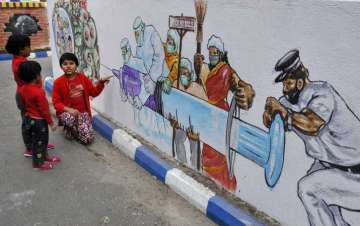From worst hit to reigning in pandemic - How India tackled Covid waves effectively when China failed miserably
From the first nationwide lockdown to people finally being able to throw their masks in the air, the journey towards an almost covid free society was estimated barely achievable. But India proved them wrong. Here's how

India has been through quite a roller coaster since the beginning of the pandemic. From the first nationwide lockdown to people finally being able to move in public without their masks, the journey towards an almost covid free society was estimated barely achievable. India was projected to be the 'worst hit' in the world during Covid-19 - given the massive population and the living conditions of most slums in the country. But we proved them wrong.
As of Tuesday's data on the deaths due to coronavirus, the fatalities count in the country came down by 87% from 2021.
Year |
Covid deaths |
| 2020 | 1,48,994 |
| 2021 | 3,32,492 |
| 2022 | 42,207 |
The first-ever coronavirus case was detected in China's Wuhan in November 2019. Before the world knew it, soon the cases spread like wildfire to each country in the world. The World Health Organisation (WHO) termed the disease a 'pandemic'. By March 2020, countries shut down, borders were closed, and businesses went MIA. Experts anticipated an economic fall throughout the world. And there was no cure or vaccine in sight. India was no guest to the horrors that shadowed.
But the country rose through, arguably better than other developed countries in the world.
How the second wave was deadlier
As the data on the above table suggests, India's worst year for the pandemic was the first half of 2021. Vaccines were launched in January that year, but the public was beyond the black stump. With ambitious goals of vaccinating 300 million by summer, India's health took a screeching break during the second wave.
With the rise of the delta variant, the health system in the country was bleeding. There were more hospitalizations than ever, and 3,000 cases were being reported every hour. Hospitals suffered a major shortage of oxygen, and patients suffered a lack of beds and medicine. The government turned its backs on protesting, crying families of those on their deathbeds who were in desperate need of healthcare. The nation was at its worst - in all ways.
Data also shows that by the end of 2021, India had recorded over 2.4 crore cases, double to 2020. The official death toll, experts argued, was way lesser than the original number - considering how parks and gardens were made crematoriums amid overflooding of bodies.
The thought of recovering from this loss was miles away and seemed too ambitious then.
Vaccinations, and their impact on the third wave
While all kudos to the society and the government's joint efforts to power through the pandemic, most credit goes to the vaccination drive. The pace of jabbing picked up, despite a bumpy start of 'vaccine diplomacy', by giving away millions of shots to countries like Nepal, Sri Lanka, and Brazil.
By February 2021, only 2% of the country was jabbed. By October the same year, the country hit the one billion mark for vaccinations.
This made not just the people immune to the infection, but the markets stronger and the nation's fight robust.
After the second wave, by June-July, restrictions were relaxed and gatherings were allowed again. People were seen going back to their pre-pandemic lives, slowly but surely.
Then came the third wave.
'Omicron' - The feeble threat: While the nation was gripped with fear of a 'third wave', that experts said was on its way since the end of the second wave, deemed itself to be feeble. Despite the rise in infections throughout the country, the Omicron variant was mild. There were not as many hospitalizations, and the death rate came down by a drastic percent.
A comparison
PM Narendra Modi had told the nation, multiple times, and the world too, that India's fight against Covid-19 is uncomparable. He said that with 'Aatmanirbhar Bharat', India's vaccination feet are above the world's attempts at a crucible attempt to deter covid.
Currently, China has locked down its top cities, including Shanghai. With a 'zero-Covid' approach policy, China had shut down its operations. Stringent restrictions and videos of bizarre rules, including those of where residents are locked inside, are being widely shared on social media. Residents have been complaining about inaccessibility to necessities like food, medications, and medical care. The local government, which comes directly under the central government, has been under fire for its intermittent rules.
Protests, singing and chants from balconies have been sounding eery in the backdrop of counterless announcements of more and more rules by the state.
News agencies have reported that volunteers are stepping up where the government has failed, organizing large wholesale grocery orders for their buildings, helping administer Covid-19 tests, and organizing medical care for those in need. Shanghai’s Covid-19 response system has relied on volunteer efforts throughout the pandemic, to support data collection, contact tracing, and eldercare.
In simple words, China hasn't been Covid-free for months.
India's methodology is far from normal from the neighboring country. Restrictions and mask mandates on the 1.3 billion population have worked remarkably well. Every citizen in the country now has access to vaccinations and is aware of the rules. The question of how the nation worked well with a huge population to fight covid boils down to one answer - cooperation. Between the government, the society, and the workers.